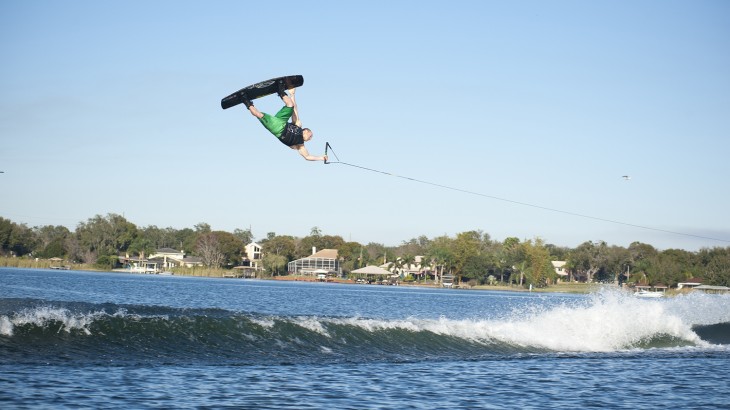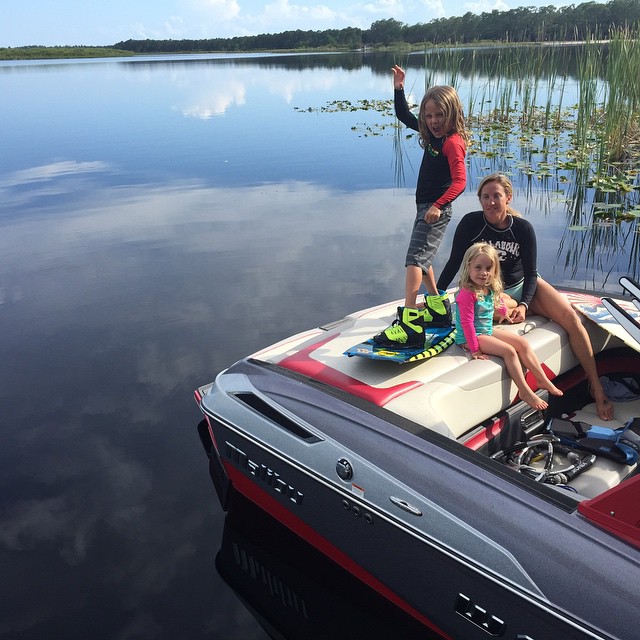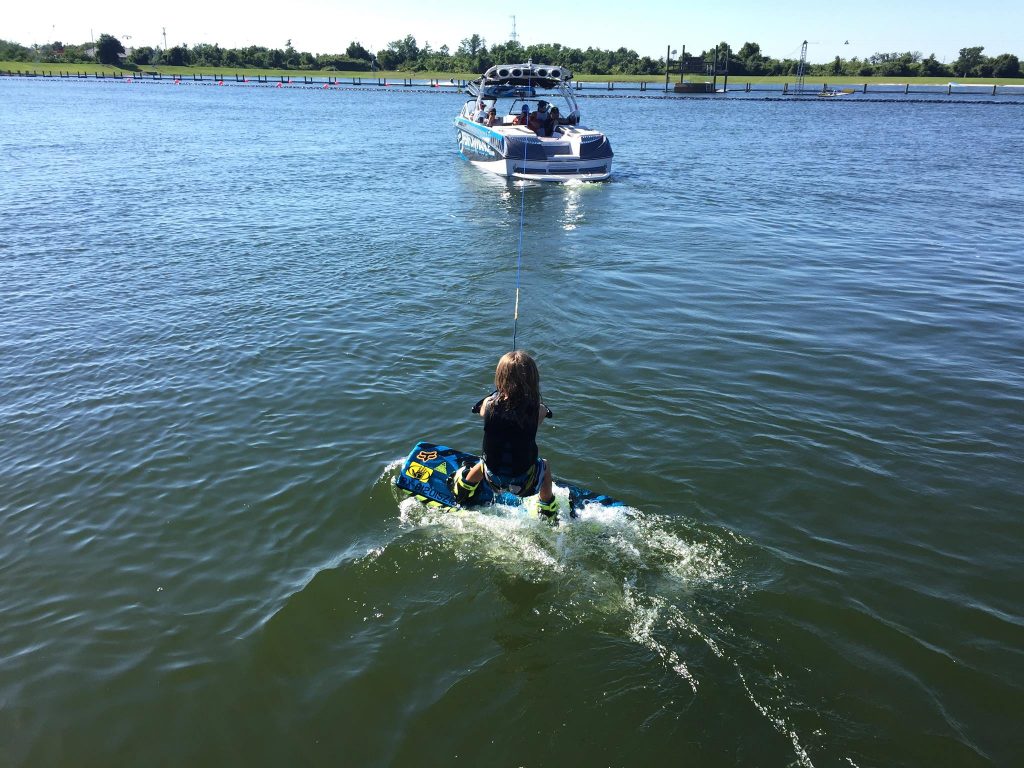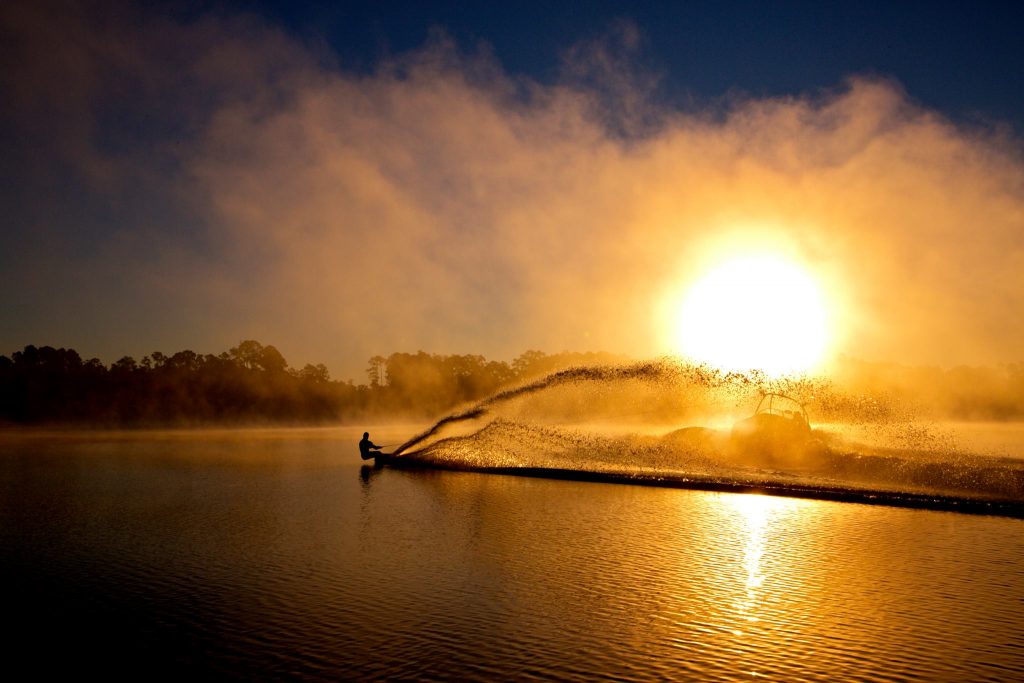
25 May FULL CIRCLE – An Interview with Darin Shapiro (Part 3)
WHF: Do you think the current state of Wake is in a good place right now?
DS: No. Wakeboard sales have gotten very soft. The contests, at least here in the U.S., don’t have the spectator crowds that they used to. The types of sponsors that were in our sport, year’s back, aren’t what they are today. I think it’s difficult to be a pro athlete in the sport today and it’s difficult to be a company, strictly based on wakeboarding. That doesn’t include wakesurfing and other things. It’s gotten super technical, and there are amazing athletes in our sport. This is not a knock to them by any means. But trick skiing got so technical that people started to look at it and say, “Well, I’m not really sure what they’re doing?” To participate in a sport like that, it’s so super technical, someone doesn’t want to pick one up and go, “I think I want to do those tricks.” That’s when wakeboarding showed up with something simple and fun like grabs, Raley’s, big air and an easier board to ride rather than a trick ski.
Now, wakeboarding has gotten very technical, very expensive and a lot more dangerous. I think people are looking at it now like they look at somebody who goes
out and does one of these massive runs and they’re not sure if they want their kid doing that, or if I’d ever do that. So, what do they do? They say to themselves, “Oh look, here’s something fun, wakesurfing.” So, I feel like the pattern is very similar with what I’ve watched happen growing up with trick skiing. And then trick skiing fell off. Believe it or not, waterskiing had great crowds when I was growing up. Lots of spectators! I feel like we had that really nice upswing of how the industry of wakeboarding, the riders and the sponsors really grew. Now I feel like it got extremely technical, expensive and people started to look for something different and fun again. So, at the risk of getting punched in the face, I did just compare wakeboarding to trick skiing (laughing). It’s just a similar pattern that you’d see if you watched it all happen the way I watched it happen over those time periods.
Understand where I’m coming from. I wished there were ten million people in the U.S. wakeboarding. It would make my life a lot easier. But what do we get? We get a lot of guys getting banged up, getting older. There is still the younger group of kids who want to go out and blast, and that’s super cool. But the sport has gotten extremely technical. Look at the price of equipment and boats right now? It’s not
quite as fun-looking from someone peering into our sport and saying, “Maybe I’ll just grab the wakesurfer and go out?” No one is getting banged up there and they’re on the boat, and enjoying themselves. That’s the bottom line, right? We’re all in these things to have fun.
WHF: Do you think the prices in the sport, like boats and equipment, have narrowed the market and are pushing the common man out of the sport?
DS: Let’s face it. It’s always been an expensive sport. Now here come the cable parks, making it way more affordable and growing the sport in a different way, to a different group. A different economical situation really, which is great. But I’m not sure where wakeboarding itself, especially boat riding, is heading at the moment. It seems there’s still a lot of excitement in Australia, and I’m stoked for those guys. In the U.S., it seems to be quiet at the moment.
WHF: You started Grind Water a few years back. What is the current status of the company?
DS: We were doing really well for a little while. I think we were a few years too early to the wakesurf market, and it was the first major company that I owned. I could have definitely done things differently and spent our dollars more wisely. But in the end, it was all the other major brands coming in and being so strong with wakesurfing right off the bat, and being able to sell similar products a lot cheaper because they were building in large volume. It’s a very tough industry. We had an awesome product and I think if we had better timing it would’ve been great because nobody knew that wakesurfing was going to explode the way it did. I think we were just a little too early to the party.

Switch Beesting (Photo Joey Meddock)
WHF: Your son Kien is a little ripper. Does he have the same kind of drive and competitiveness as you?
DS: So I have two kids. Kien is nine and Kaia is five. Kaia is more like the spitting image of dad. She’s really strong, a little aggressive and she’s a very determined little girl. My son, Kien, is a little bit more cerebral. He takes a look at things and thinks about it. He’s not your fearless, go charge it and see what happens kind of kid. He’s smart and careful. He’s a great little athlete but he’s a lot more like mom. And my little girl is more like me so we’re going to have to see what’s in store for her.
WHF: Do either of your kids have any of the ambitions that you have/had when it comes to riding? Or do you have different personalities in that aspect?
DS: We haven’t ever pushed our kids into something that they were not interested in. Because if they don’t want to do it, why do we want them to do it? So we’ve introduced him and given him the opportunity. He’s excelled in and loves sports. I can honestly say I don’t know what his favorite sport is (laughing). If he wants to do something, we’re doing it. But it’s his decision. It’s not mom and dad’s decision on what sport he’s going to do. He’s so young that we don’t mind that he hasn’t made a choice yet and we’ll just keep having fun with everything. He’s a little kid, we’re going to have fun, and that’s what matters more than anything.
WHF: Does your wife, Heather, ever wakeboard?
DS: She’ll probably wakeboard once or twice a year, but she’ll wakesurf anytime. We still go to the beach and surf a bunch so when we’re home and wakesurfing, she grabs her board and she’ll ride.
WHF: Has wakeboarding ever come between your relationship?
DS: No. I’ve known Heather since she was thirteen, and I was fifteen. There’s only been the question of a knee surgery here, a shoulder surgery there, “Hey honey, are you sure you really want to do this more?” You know, that kind of conversation, because she takes care of me. She knows if I get hurt it’s more work for her (laughing). But no, I’m so lucky to have a wife, a friend, who embraces these activities and knows that this stuff is life for me. Even if it means skirting on the occasional whatever else, she looks in my heart and she knows this is me. It’s been nothing but support, and she knows sports are just so healthy for all of us.

Family session back in 2015 (Shapiro photo)
WHF: You do a lot of coaching as well. What is your coaching philosophy when working with students, including your own kids?
DS: I think the most important thing for me is to teach people how to learn safely and not to hurt themselves. This is an impact sport, and when people get banged up, the fun stops. If we want to keep people enjoying our sport, sometimes we have to keep them from hurting themselves, even if that means a slower learning curve. Which sometimes is the hardest thing to teach the parents.
WHF: When a lesson is done, what do you, as the coach, like to see or feel when the rider leaves your boat?
DS: A smile is the main thing for me, and to see a light bulb go on for them. Where they understand something that they can take home and build on. You know, the look on their face like they’re getting it? That feels like an accomplishment for me because it’s not cheap for people to train on the boat. So it’s important for me that they really got some value from the experience.

Kien at the 2017 Gravel Tour (Shapiro photo)
WHF: What is your consistent advice to riders or their parents when you meet them for the first time?
DS: It’s so important for parents who have younger kids to understand that most of their learning at a young age needs to happen through play, or needs to be playful and in a social atmosphere. I’ve learned that ultimately, you don’t want to take a little kid, stick him with one coach and tell them we’re training now. It’s not that fun for a young kid. So try to find an environment that there are young kids and more experienced riders as well. That way, it’s not like you’re trying to train this kid but he’s learning through play in the right environment. They’ll learn quicker from wanting to impress their friends than they ever will from a coach trying to tell them that they’re training. That’s just from my experience and I’m not saying that’s always the way it is. But most of the time that seems to be the way a kid stays happy and motivated.
WHF: Have you ever had a disagreement with a set of parents because their motives differed from you with regards to their kid(s)?
DS: It’s real simple. If the parents are pushing their kids into something they don’t want to do, you usually don’t get good results. If I see this happening, I will talk to the parents about it. Or it may be a situation where the parents don’t understand the kid may be in danger, like the parent wanting them to do a flip that maybe they aren’t ready for, and unfortunately sometimes it’s my job to say, “No, we’re not going to do that right now.” Sometimes the look on these parents faces, and they quickly respond by saying, “Well, we’ll go to somebody who does want to teach them that.” I’d prefer they move on, as opposed to being involved when a kid gets hurt.
WHF: The late, Steve Prefontaine (American Olympic long distance runner), once described a running race as a “work of art”. What does wakeboarding mean to you?
DS: I always fall back to a similar theme of “Learn it, and then learn it big!” When I see riders take that philosophy, it makes me feel good about the sport. Because I look at it like a gutsy sport, and when riders embrace that, I look at it like that’s the way it supposed to be done. Everybody learns a trick, but not everybody learns a trick and then says, “Well now how big can I do that?” I have nothing but respect for the gutsier riders who take that approach. Dean Smith is a great example. The guy learns a trick and then he says, “Huh, how hard can I cut at that?” That makes me feel good when they ride with that much heart. I don’t have a single word to describe it, but it makes me smile when somebody embraces the sport with that approach. I like watching the physics of our sport in action. The speed, the height and all these things happening, it all has to be right for a big, beautiful trick to be landed. Just watching that process when it works right, I sit back and go, “Yeah, that’s how it’s supposed to look.”
WHF: Do you ever see yourself on the business side of a wake company again?
DS: I’d always love to be involved in any part of this business. It will always be a part of who I am. That’s a door for me that will never close.
WHF: What moment in your career are you most proud of?
DS: There’s been a list of achievements that have meant the world to me, and it’s hard to pick a specific moment. But a definite peak was winning the X-Games for my first time because I felt like wakeboarding was on its highest platform. I knew winning the X-Games was going to mean a lot to me, so that felt like a major accomplishment.
WHF: Is there a specific rider, past or present, who you really admire?
DS: I admire a bunch of guys for a bunch of different reasons. You’ve always got Murray who has been an excellent face of our sport. Then you have a guy like Danny Harf, who probably could’ve been a pro at anything. And you’ve got Parks. He’s like a chameleon. Whatever you put him on, he’s going to make it work. He’s just got crazy, natural, athletic ability. These days, you’ve got guys like Dean Smith, who’s so aggressive with today’s big wakes and just hangs it out there. Love it! More so lately, I watched an edit of Mike Dowdy, and that for me was the most impressive performance in wakeboarding I’ve ever seen.

Resurgence 2014 (Photo Tanya Pavlis)
WHF: Which rider would you want to emulate and why?
DS: That’s a really tough question because the styles have changed so much over the years. If we were talking about different eras, I’d want to be a different rider. I just see myself taking a small piece from a lot of different riders and then putting them all together. Randall has always been a gutsy rider, and the ballsy riders have always been my favorite. His individuality was always the strongest thing about him. As well as I just love how big he goes!
WHF: What would your epitaph say?
DS: (laughing) I’ve never thought of that before, ever. I don’t know how I’d put this into an epitaph but my greatest risks that I’ve taken have been the biggest successes in my life. I’ve always told people anything short of killing themselves, with big risks come big rewards, but you’ve got to be smart. You don’t want to take stupid risks, but anytime I’ve had great success in this business has been from hanging it out there.
WHF: Anyone you’d like to thank?
DS: For sure! I’d like to thank my wife, first. Of course, my family, which includes Mike Ferraro. Also, I’d like to give a special thanks to Herb O’Brien because my career may not have been possible without him. Finally, thank you to the Wakeboarding Hall of Fame. I’ve had amazing support from different friends and riders over the years, but mostly I’m just thankful to have been a part of the sport.
WHF: Darin currently lives in Orlando, Florida on Lake Mary Jane. If anyone is interested in private, one on one coaching, you can contact him through his website at http://darinshapiro.me.
About the Interviewer: Ryan Shimabukuro was born and raised in Hawaii. He is an avid wakeboarder currently living in Utah with his wife and two children. Ryan has judged at the professional level, including the Gravity Games, U.S. Pro Tour and Malibu Open.
(Header photo: Tanya Pavlis)



Sorry, the comment form is closed at this time.